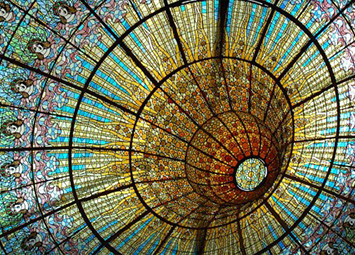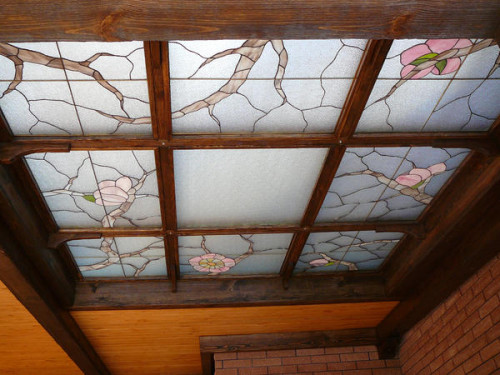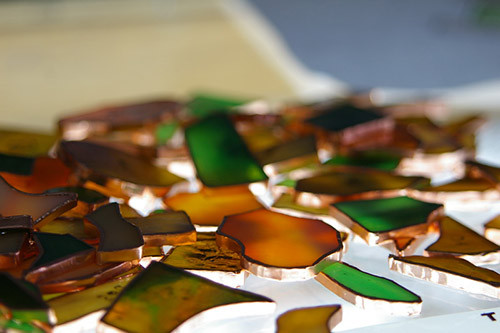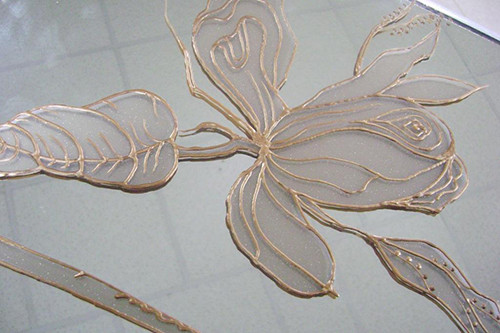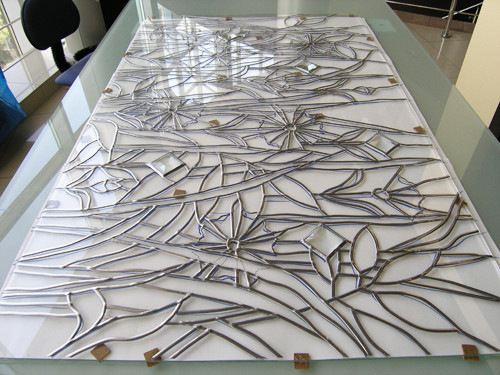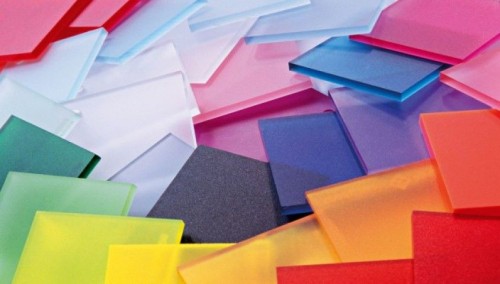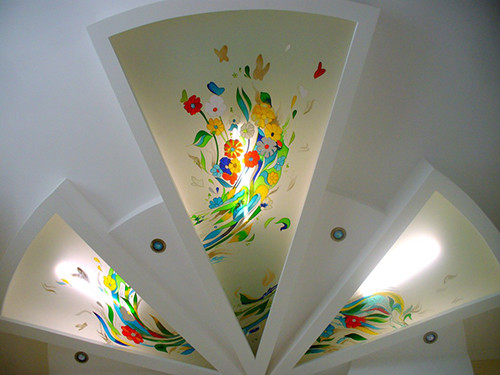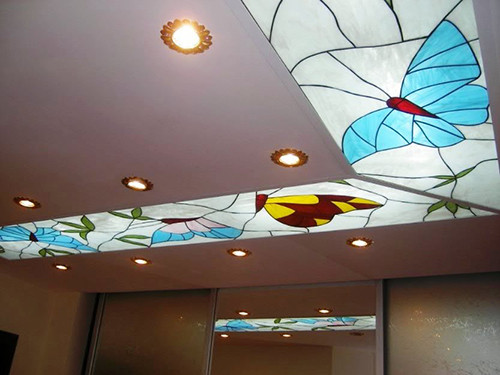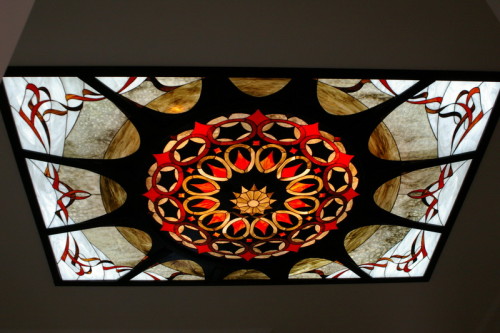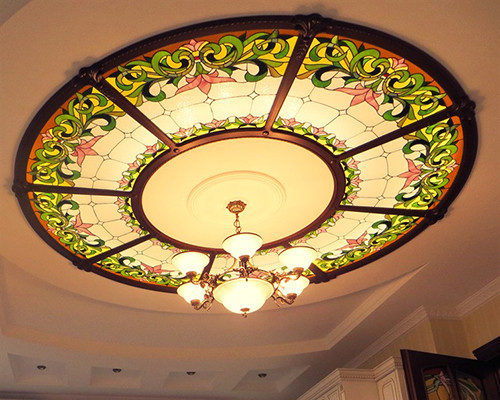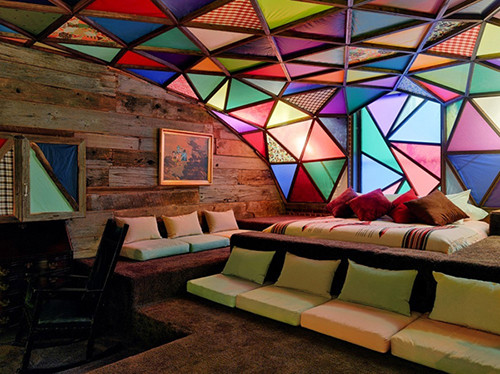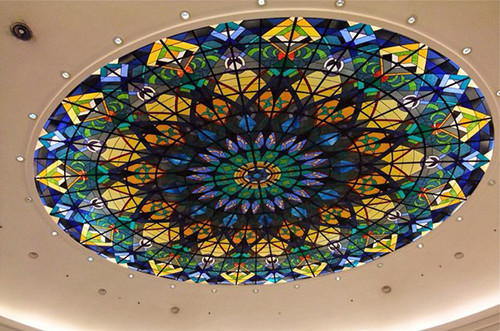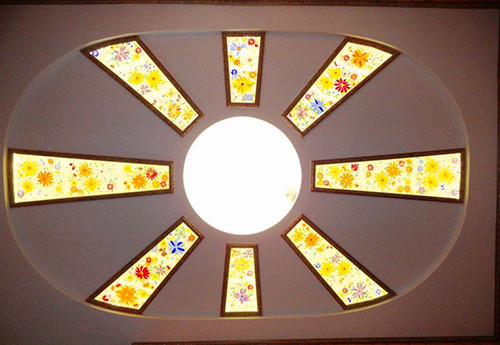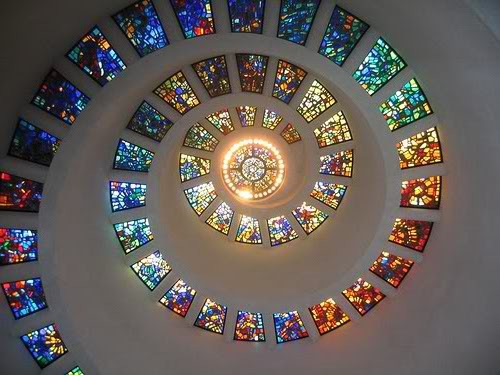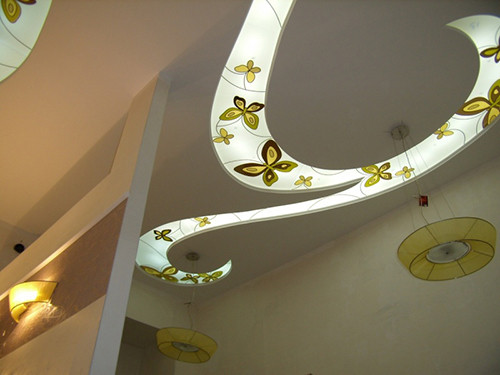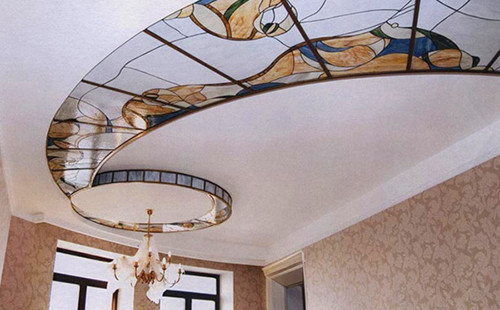Any owner, planning repairs, seeks to make his housing not just comfortable, but beautiful and original. At different times, the finish of the ceilings had its own specifics - they were whitewashed, painted, sheathed with wooden panels, used suspended ceilings, even pasted with wallpaper. But one of the most unusual, popular and constant trends was the creation of stained glass. This is one of the most expensive and beautiful decoration methods, and today we will talk about how to make a stained glass with our own hands.
Content
Design features
An ordinary stained glass ceiling is a surface composed of painted square elements with a side of 30 or 60 cm. The slabs are fastened to each other and hold the suspended system located just below the main ceiling.
What is good stained glass:
- Simple installation - this does not apply to all types of ceilings, but no matter what construction you choose, for it there is no need to carefully prepare the surface, since the stained glass elements are attached to the metal frame. The complexity of the installation depends on the configuration of the room, but in any case, it will take less time than the traditional finish.
- Practicality - caring for a stained glass ceiling is very simple - it is enough to wipe it with a rag. If one of the elements is damaged, it can be easily dismantled and replaced without analyzing the entire structure.
- Durability - if the whitewashing on the ceiling is darkened and polluted over time, then the stained glass ceiling with proper care does not lose its original beauty for many years and even decades.
- Environmental friendliness - since stained glass ceilings consist of glass, they are not able to harm human health and the environment. Stained glass paints also do not contain toxic substances, so such ceilings can be installed in any room.
- Moisture resistance - glass does not pass water, so with proper installation, the stained glass ceiling will create additional waterproofing of the room.
- Aesthetics is the latest item on our list, but it is precisely because of high aesthetics that many prefer to install stained glass ceilings at home. A variety of colors, shapes and compositions is limitless, so you can easily choose the right option for any interior.
Since we mentioned diversity, it is worth noting that stained -glass windows are not only rectangular. There is a separate classification in forms. So, domed ceilings have a characteristic design in the form of a convex or concave into the bowl. Such volumetric ceilings can be found in medieval temples or ancient theaters. Round ceilings have recently become very popular in private construction, since they give an unusual look to the interior. Stained glass ceilings can also have non -standard forms, for example, in the form of petals or flowers, animals, polygons, etc.
Classification of stained glass ceilings
To choose the design of the stained glass ceiling, you should understand the classification. Depending on the manufacturing methods, the specifics of the installation, shape and availability of the structure of the structure are divided into several types. Clearly indicating which type of ceiling is suitable for your home, you can determine the method of installation and features of operation.
Image application method
Drawings on stained glass ceilings are applied in several ways. There are film coatings and structures collected from separate multi -colored elements. In the first case, the pattern consists of two layers - a colored film is glued onto the glass plate.
This is the most economical option, but not at all as durable as real stained -glass windows. The film is quite fragile, and it can be easily scratched, but if you exclude the factor of mechanical damage, such a ceiling will last for many years.
Stained glass ceilings, consisting of individual elements, differ in greater strength and durability compared to film. Pieces of glass connect lead or copper veins, and the entire structure holds a strong metal frame.
According to production technology
If earlier the creation of stained glasses was equated with high art and required exceptional talent and skills, then modern production technologies made it possible to significantly simplify and diversify this process.
Stained glass windows are made in several ways:
- Sand -cut - a color image is applied to matte glass. First, the smooth surface is treated with a stream of compressed air so that it becomes matte. Where the stream has passed more than once, glass changes the shade and degree of roughness. Then stencils are applied to the surface and drawings are applied in the same way (even more matte or glossy transparent). This technique allows you to create compositions not divided into parts.
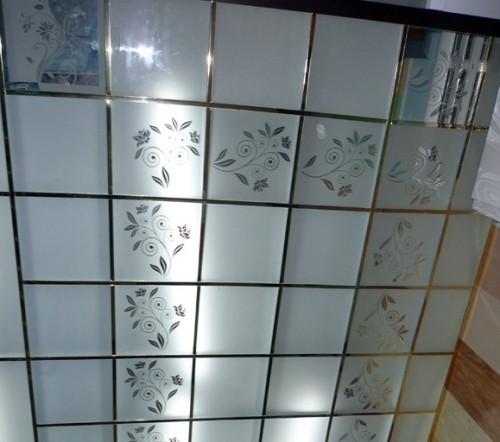
- Photo printing - using this technology, any image can be placed on the ceiling, starting from a simple landscape, ending with a photograph or copy of the picture of a famous artist. In a chopped house, a stained glass ceiling with photo printing can display thick crowns of trees or a cloudless sky, thereby focusing on the naturalness and naturalness of the interior. In the children's room on the ceiling, fairy -tale characters or constellations can be depicted.
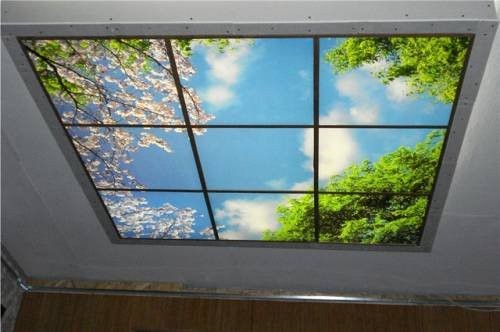
- Contour - this technology allows you to imitate real ancient stained -glass windows. First, the designer applies the contours of the future pattern with polymer thick colors, and when they dry, the cells inside are poured with multi -colored enamels and varnishes. We will talk more about the process of creating such stained glasses a little later.

- Tiffany is one of the most luxurious and expensive types of stained -glass windows. The structures consist of a large number of separate glass elements wrapped on the sides of copper or tin foil. In one composition, several types of glass can be used - matte, glossy, color, transparent, relief, etc.
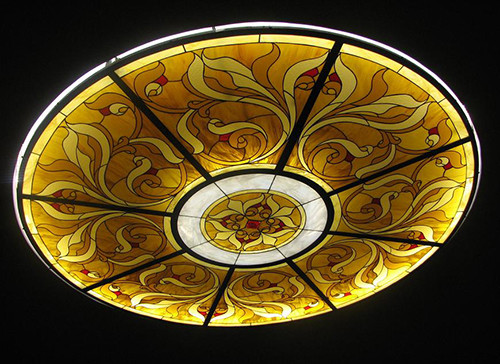
By the method of installation
If you can make a stained glass ceiling using a suitable technique, then installing it in your rightful place is not so simple. Glass is a rather difficult material, working with which requires a certain dexterity and professionalism.
Depending on the installation method, two types of structures are distinguished:
- Stretch stained glass ceilings - are distinguished by ease of installation and do not need to equalize the base. If the ceiling is provided for the backlight, you should decide on its location (you need a wiring plan). The fastener profile is an aluminum structure or PVC baguette attached to the ceiling with self -tapping screws or dowels. To make high -quality installation, it is necessary to eliminate the occurrence of gaps in the joints and provide the most strong fastening. Holders of built -in elements are installed on the frame, screwing the racks to the base according to a pre -created marking. Usually stretch ceilings are made with photo printing.
Important: special attention when installing a stretch stained glass must be paid to the quality of the electrical wiring, because after the completion of work to it there will be no access.
The disadvantages of this method include not only blocked wiring, but also fragility and inability to withstand temperature changes. - Suspended stained glass ceilings - consist of a metal frame, on which plasterboard slabs or modules are attached. As a result, there is a free space between the base and the suspension structure, where the wires can be hidden. The stained glass suspension ceiling is mounted when the interior decoration of the room is completed. First, suspensions of thick wire are attached to the base, a frame, guides and slabs are mounted on them. The main disadvantage of this installation method is to reduce the height of the room and unreliability (it is better to attach a heavy chandelier to the main ceiling).
Stained ceiling with backlight
Stainflowing with backlighting can not only decorate any room, but also provide an additional light source. And since stained -glass windows in most cases are made of multi -colored elements, you can imagine how beautiful and unusual light passes through such a coating.
By the method of backlighting, several design options are distinguished:
- The chandelier - such a stained glass ceiling looks like a large open -type lamp with a forged or specialized metal frame. The chandelier is attached to the black ceiling with chains on a powerful anchor hook.
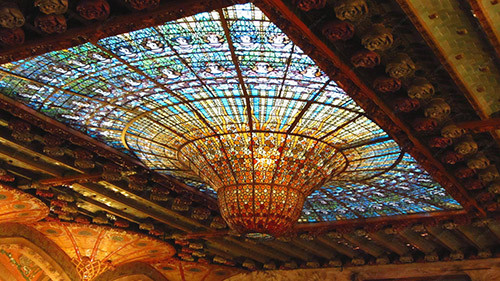
- The ceiling lamp is a stained glass insert (several inserts) mounted in the ceiling itself. It can be installed in a suspended structure or in a niche made of drywall.
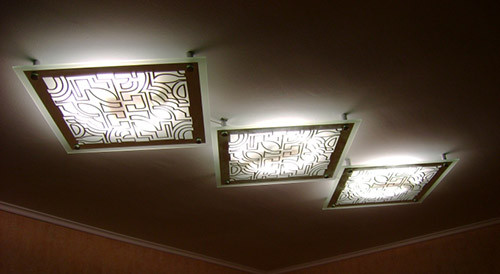
- Plaphon - a cup of colored glass or covered with stained glass painting, which is inserted into a niche or fixed with profiles.
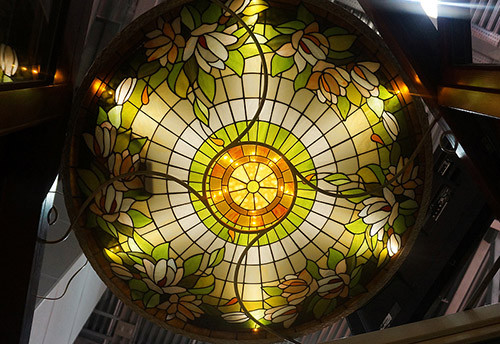
The installation of any of the above types of structures should start with the electrical wiring for each lamp. The optimal distance between the ceiling overlap and the stained glass frame should be at least 15 cm. Also, when organizing the ceiling with the backlight, it should be borne in mind that all structural elements should be removable. Otherwise, maintenance will be impossible.
Stained glass technique
Initially, the stained -glass window technique was used to decorate majestic cathedrals, but over time it began to be used everywhere, and today anyone can get a stained glass ceiling. The most remarkable thing is that you can make a characteristic pattern with your own hands. The industrial method is very time -consuming - multi -colored glass should be baked in special forms at high temperature. However, the result justifies all efforts - stained -glass windows are very beautiful and strong. At home, you can create the same spectacular compositions, but use easier methods.
Glass painting
In any art store you can find paints or special sets for stained glass painting. To create a drawing, you should draw a sketch on paper on a 1: 1 scale and choose strong glass.
Necessary tools and materials:
- alcohol;
- stained glass paints;
- brushes;
- glass markers;
- stencils (if you are not sure that you can perform the drawing yourself);
- cotton sticks (wash irregularities and remove excess paint).
The glass is completely washed and degreased with alcohol. The sketch is laid on a flat surface and covered with glass. The marker is drawn by the drawing along the contour, and then decorated with special paints. To make the drawing more saturated, you can apply paints in several layers, but you should wait at least 12 hours before applying the next layer.
Important: very often from habit during painting in a layer of paint, air bubbles are formed. You cannot leave them, so carefully pierce them with a needle.
When the work is finished, the stained glass window must be left to dry for three days, after which you can proceed to the installation.
Useful advice: instead of a marker, you can use special contours on the glass - they will give a volume drawing.
English stained glass
The English technique for performing a stained glass is slightly resembles the previous method, but as a result the picture is more voluminous and “expensive”.
What will be needed for work:
- glass;
- sketch on a 1: 1 scale;
- film for a stained glass window;
- roller;
- scissors;
- lead tape;
- soldering iron;
- solder and flux.
It is recommended to work on a large flat table in good light. Clean low -fat glass is placed on top of the sketch, the contours are outlined with a lead ribbon. In this case, it imitates the seams, as on real ancient products. Then the glass is turned over and a special colored stained -glass film is glued to its back. The lead tape is again fixed on it along the contours, after which the joints are sealed.
This technique is especially popular when creating ceiling lamps. The result is very spectacular interior details without special financial investments. To make a beautiful stained glass window, it is not even necessary to have artistic talent, you just need to choose the right film and drawing.
Imitation of a stained glass window
There is a couple of techniques with which you can make a convincing imitation of stained glass. They allow you to create beautiful compositions at home without special preparation and skills.
A prefabricated stained glass can be made of multi -colored glass. To do this, you just need to choose the picture you like, transfer it to the cardboard in any convenient way (large drawings can be transferred using the projector). Next, individual fragments should be marked with colors and lay out into slices of glasses like a mosaic. For fastening it is better to use colorless silicone glue.
Useful advice: so that such a ceiling does not turn out too heavy, use thin glass. It will be much easier to divide into fragments for “mosaic” with glass cutting.
For the second method of simulating a stained -glass window, paint and soft wire are needed. The glass is placed on the pattern, and the contours are made of wire, gluing it with colorless glue. Fragments between the wire are poured with aniline dyes, after which everything is covered with transparent varnish. With the help of this technique, you can quickly and inexpensively make a stained glass ceiling in the bathroom, living room, decorate the windows on the balcony or attic.
Installation of stained glass ceiling
Installation of a stained glass ceiling can occur differently depending on the mounting method. Since the work is associated with a certain risk (glass may fall, split, cut), installation is best done with assistants.
Fastening methods:
- Installation in a suspended ceiling is quite simple, and therefore the most common method of installation. Due to the fact that the underground space should be at least 15 cm in width, the height of the room is significantly reduced, but it becomes possible to carry out and hide all communications.
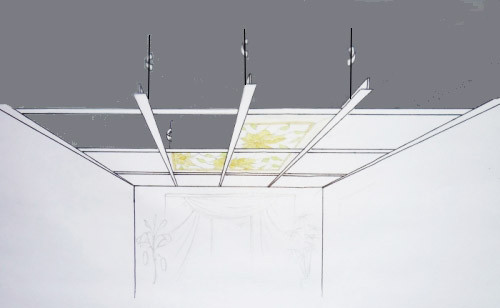
- Installing a stained -glass window on a decorative ledge just below the level of base.
- Installation in the “box” - this technique is used mainly for massive stained glass ceilings with backlighting.
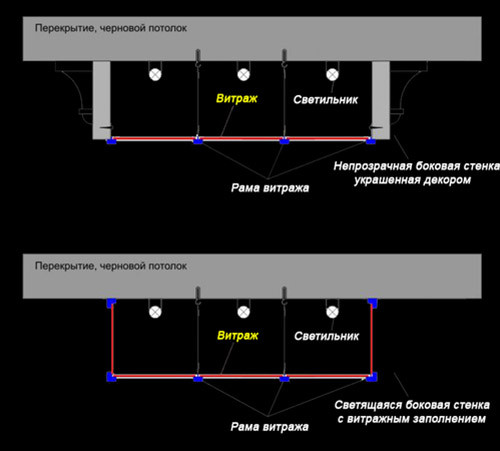
Since the first method is the most common, consider it in more detail.
The course of work:
- First, you should create a supporting frame and attach it around the entire perimeter of the ceiling. To do this, on the basis of the place of fastening of suspensions with a step of 60 cm in parallel on the supporting profiles.
- At the intended points, drill holes and drive the steel anchor bolts 20 cm long. The number of anchors depends on the mass of the stained glass, but it is always recommended to drive a little more for insurance. On average, 8-10 pieces will need.
- Fix the profiles on suspensions and guides.
- Fix secondary profiles in places of future docking of stained glass elements. As a result, a coat of a single -level frame should be obtained.
- During the installation of the frame, you should constantly monitor its evenness with the help of the building level. Otherwise, the glass may just fall out. As auxiliary guidelines, a thick fishing line or cord is used.
- The installation of glasses is carried out using self -tapping screws. Each glass plate is placed in a cell of a metal frame, checked and fixed. Several elements are left not blessed so that at any time you can get to communications under the ceiling.
- For illumination, use spotlights located outside along the contour, or neon pipes or fluorescent lamps installed inside. The latter option gives an impressive effect, because that the stained -glass window is completely glowing from the inside, which is very beautiful. LED backlighting is very popular, especially when it comes to your own installation. It occupies a minimum of space, easy to install, durable (it can last up to 10 years), it can be different colors, which allows you to emphasize the beauty and saturation of the stained glass composition.
The video below shows an example of LED backlighting, changing color:
To make such lighting, the LED tape is fixed 7-15 cm from the back surface of the stained glass in several parallel rows.
Important: light passing through multi -colored glass loses its brightness, so it is recommended to organize additional lighting sources in the room.
Stained ceiling: photo
If you started repairs and want to completely change the appearance of your housing, a stained glass ceiling will help create a completely unusual atmosphere. Warm tones in the living room or bedroom will allow you to relax, “fresh” notes of green, yellow and orange in the kitchen will quickly cause appetite, blue and white shades will decorate the bathroom ... Ideas for creating stained glass ceilings, and to inspire you to create our own original compositions, we We made a photo selection of beautiful and unusual work.
